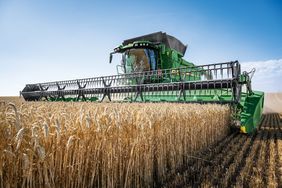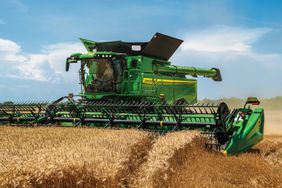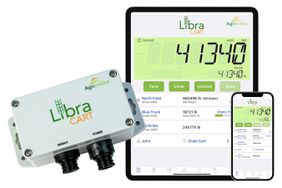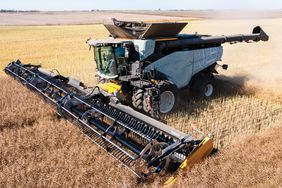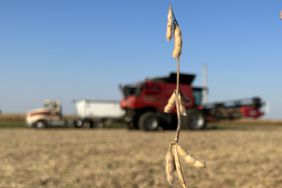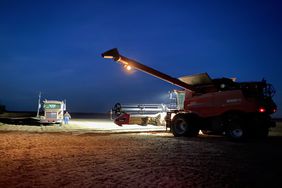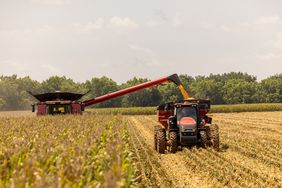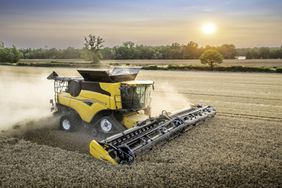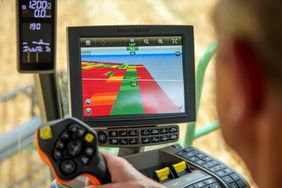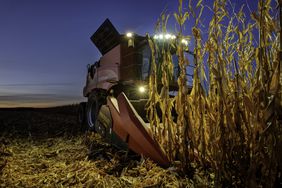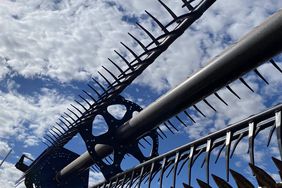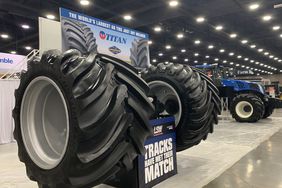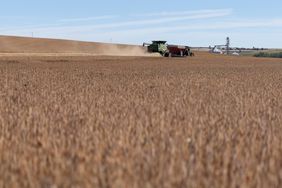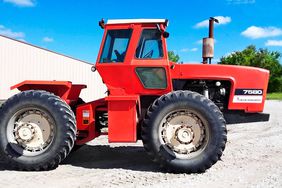:max_bytes(150000):strip_icc()/unspecified-3-02640f8637b94101a14328ee6626a1fd.jpg)
It's finally realistic to ditch the tractor and grain cart and head out to harvest with just one machine — the Tribine. This combine-grain cart combo can haul 1,000 bushels of grain and is compatible with standard headers that can even be pulled behind the machine for easy transportation.
With a tank that's able to load up with 500 gallons of fuel, the Tribine should be able to run for 24 hours, which is over 11 hours longer than conventional combines. When it's time to unload, it can be done at a rate of 8.5 bushels per second, which adds up to unloading over 500 bushels per minute.
If your brain is screaming COMPACTION when you see pictures of this 48,000-pound machine, know that Tribine says the machine has the lowest compaction of any system. It accomplishes this with four aligned low-ground-pressure tires that can turn the machine in a pretty tight radius with the help of all-wheel drive.
The Tribine is powered by two Cummins diesel engines at 590 hp. If the Tribine engines need serviced, a local Cummins dealer will be able to make that happen.
Threshing and Cleaning
Because the Tribine carries grain exclusively in its rear module, it has much more space behind the cab to dedicate to cleaning and threshing. Compared with conventional combines, the Tribine's cleaning area is more than 4,500 square inches larger, and the separating area is over 480 square inches more spacious.
:max_bytes(150000):strip_icc()/unspecified-1-2-3796198fcf3c4644aa31e5a865643a94.jpg)
The concave area is also impressively large with roughly 1,800 square inches more space than conventional combines. The Tribine's rotor has a swung diameter of 38 inches, and the concave wrap uses a 270° area.
When the clean grain moves on to the grain tank, the remaining chopped chaff is shot out of the Tribine's two side discharge choppers. Chaff can be distributed up to 50 feet away from the machine via the choppers.
The Cab
The cab was created for optimal visibility. This cab has no steering wheel, but instead has a single steering joystick. Without a steering column blocking the view of the header and field, growers can see directly out and also can see below via the cab's glass floor.
Each Tribine is lit with LED lighting to light up the area around the machine, so seeing at night shouldn't be an issue. Plus, operator control cameras and extra large side mirrors contribute to making sure producers have full control of the Tribine's actions.
A Long Time Coming
The Tribine has been around in some capacity for at least three years — being tested in the Newton, Kansas, area that the company calls home. Unfortunately, Tribines will only be available to a limited number of growers for 2017 harvest. The company is currently taking orders for the new harvesters, and growers should expect to pay the equivalent of a combine and a new grain cart when they invest in one of these machines.
"We are intentionally producing a limited quantity of units next year, which we will sell and support ourselves," says Greg Terjesen of Tribine.
Although the Tribine has been extensively tested, growers that purchase the machine in the next year will have a "very liberal warranty coverage," Terjesen says. Tribine owners will receive a supply of maintenance parts with their new machine, but any other service needs will need to be taken care of at a Tribine facility in either Logansport, Indiana, or Newton, Kansas.
